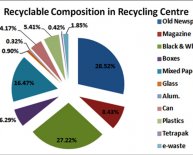
Causes of Solid Waste Disposal
Solid Waste Management - Causes and Control Measures
Human and animal activities generate different kinds of wastes. These wastes are generally in solid form, and may cause pollution of land, water, and air unless treated and disposed off. The process of collection, transportation, treatment, and disposal can be grouped under solid waste management.
Causes
The main sources for solid wastes are domestic, commercial, industrial, municipal, and agricultural wastes.
The composition of a city waste is as follows:
- Paper, wood, cardboard 53 percent
- Garbage 22 percent
- Ceramics, glass, crockery 10 percent
- Metals 8 percent
- Rubber, plastics, discarded textiles 7 percent
The increase in the quantity of solid waste is due to overpopulation, affluence, and technological advancement.
Effects of Waste Pollution
a) Health Hazard
If solid wastes are not collected and allowed to accumulate, they may create unsanitary conditions. This may lead to epidemic outbreaks. Many diseases like cholera, diarrhea, dysentery, plague, jaundice, or gastro-intestinal diseases may spread and cause loss of human lives.
In addition, improper handling of the solid wastes is a health hazard for the workers who come in direct contact with the waste.
b) Environmental Impact
If the solid wastes are not treated properly, decomposition and putrefaction may take place, causing land and water pollution when the waste products percolate down into the underground water resources. The organic solid waste during decomposition may generate obnoxious odors. Stray dogs and birds may sometimes invade garbage heaps and may spread it over the neighborhood causing unhygienic and unhealthy surroundings.
Control Measures
The main purpose of solid waste management is to minimize the adverse effects on the environment. The steps involved are:
- Collection of solid wastes
- Disposal of solid wastes
- Utilization of wastes
Collection of solid wastes:
Collection of waste includes gathering the waste, transporting it to a centralized location, and then moving it to the site of disposal.
The collected waste is then separated into hazardous and non-hazardous materials. There are a number of waste separation technologies available such as air stripping, stream stripping, carbon absorption, and precipitation.
Disposal of solid wastes
Before the final disposal of the solid wastes, it is processed to recover the usable resources and to improve the efficiency of the solid waste disposal system. The main processing technologies are compaction, incineration, and manual separation. The appropriate solid waste disposal method has to be selected, keeping in view the following objectives:
- should be economically viable
- should not create a health hazard
- should not cause adverse environmental effects
- should not result in unpleasant sight, odor, and noise
Utilization of wastes
The solid wastes can be properly utilized to reap the benefits such as:
- conservation of natural resources
- economic development
- generate many useful products
- employment opportunities
- control of air pollution
Synopsis
As a part of human life, solid wastes are generated. The disposal of solid waste should be part of an integrated solid waste management system. The method of collection, transportation, processing, resource recovery, and final disposal should be synchronized for effective implementation. This will help in having a clean and healthy environment devoid of diseases.
rtve researchgate astro.wisc.edu engawa.kakaku.com search.auone.jp telstra.com.au sitereport.netcraft.com wikimapia.org nutritiondata.self.com kaskus.co.id digitalcollections.clemson.edu superherohype.com tools.folha.com.br talgov.com minecraft.curseforge.com curseforge.com foro.infojardin.com camfrog.com popcouncil.org drinksmixer.com
















